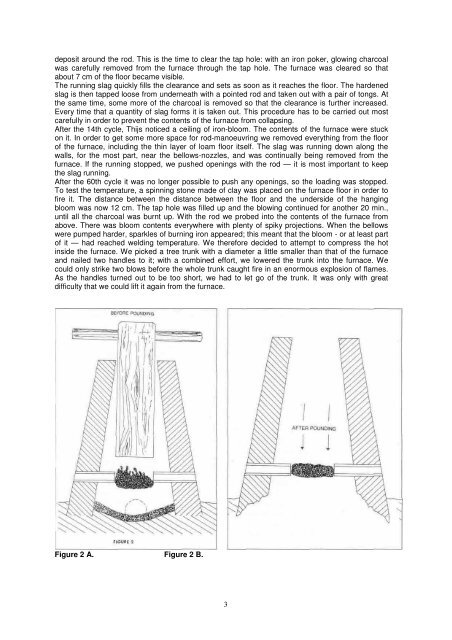1 Experiments with a slag-tapping and a slag pit furnace Anneke ...
1 Experiments with a slag-tapping and a slag pit furnace Anneke ...
1 Experiments with a slag-tapping and a slag pit furnace Anneke ...
Create successful ePaper yourself
Turn your PDF publications into a flip-book with our unique Google optimized e-Paper software.
deposit around the rod. This is the time to clear the tap hole: <strong>with</strong> an iron poker, glowing charcoal<br />
was carefully removed from the <strong>furnace</strong> through the tap hole. The <strong>furnace</strong> was cleared so that<br />
about 7 cm of the floor became visible.<br />
The running <strong>slag</strong> quickly fills the clearance <strong>and</strong> sets as soon as it reaches the floor. The hardened<br />
<strong>slag</strong> is then tapped loose from underneath <strong>with</strong> a pointed rod <strong>and</strong> taken out <strong>with</strong> a pair of tongs. At<br />
the same time, some more of the charcoal is removed so that the clearance is further increased.<br />
Every time that a quantity of <strong>slag</strong> forms it is taken out. This procedure has to be carried out most<br />
carefully in order to prevent the contents of the <strong>furnace</strong> from collapsing.<br />
After the 14th cycle, Thijs noticed a ceiling of iron-bloom. The contents of the <strong>furnace</strong> were stuck<br />
on it. In order to get some more space for rod-manoeuvring we removed everything from the floor<br />
of the <strong>furnace</strong>, including the thin layer of loam floor itself. The <strong>slag</strong> was running down along the<br />
walls, for the most part, near the bellows-nozzles, <strong>and</strong> was continually being removed from the<br />
<strong>furnace</strong>. If the running stopped, we pushed openings <strong>with</strong> the rod — it is most important to keep<br />
the <strong>slag</strong> running.<br />
After the 60th cycle it was no longer possible to push any openings, so the loading was stopped.<br />
To test the temperature, a spinning stone made of clay was placed on the <strong>furnace</strong> floor in order to<br />
fire it. The distance between the distance between the floor <strong>and</strong> the underside of the hanging<br />
bloom was now 12 cm. The tap hole was filled up <strong>and</strong> the blowing continued for another 20 min.,<br />
until all the charcoal was burnt up. With the rod we probed into the contents of the <strong>furnace</strong> from<br />
above. There was bloom contents everywhere <strong>with</strong> plenty of spiky projections. When the bellows<br />
were pumped harder, sparkles of burning iron appeared; this meant that the bloom - or at least part<br />
of it — had reached welding temperature. We therefore decided to attempt to compress the hot<br />
inside the <strong>furnace</strong>. We picked a tree trunk <strong>with</strong> a diameter a little smaller than that of the <strong>furnace</strong><br />
<strong>and</strong> nailed two h<strong>and</strong>les to it; <strong>with</strong> a combined effort, we lowered the trunk into the <strong>furnace</strong>. We<br />
could only strike two blows before the whole trunk caught fire in an enormous explosion of flames.<br />
As the h<strong>and</strong>les turned out to be too short, we had to let go of the trunk. It was only <strong>with</strong> great<br />
difficulty that we could lift it again from the <strong>furnace</strong>.<br />
Figure 2 A. Figure 2 B.<br />
3


